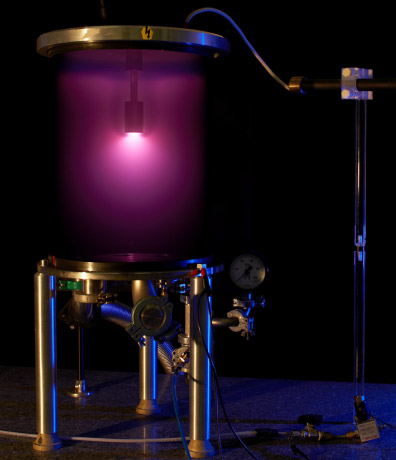Plasma au Palais
This experiment can be seen at the Palais de la Découverte, in Paris, as part of the scientific exhibition Light, lights - to explore the invisible".
"

copyright © ONERA 1996-2006 - Tous droits réservés
Photographs: Stéphane Muratet
Electric discharges in the air
Conditions under the glass cylindrical enclosure: near-vacuum (approximately some millionth with a few ten-thousandths of the atmospheric pressure) and high negative voltage of a few thousands volts
Under normal conditions, a gaseous medium does not allow the conduction of electricity. Free electrons and positive ions can however appear if the gas is subject to an electric field of strong intensity, to sufficiently high temperatures, to a bombardment particles or to a very intense electromagnetic field. When ionization is so important that the number of electrons per unit of volume is comparable with that of the neutral molecules, the gas becomes a plasma, which is a very conducting fluid.
The experiment shows that the extension and form of the luminous areas depend on the concentration and the nature of the gas in which the electric discharge ignites.
Electric discharges in the air




Evolution of the luminous zones according to pressure
from left to right: P = 375 µb, 280 µb, 140 µb, 40 µb
Electric discharges in neon




Evolution of the luminous zones according to pressure
from left to right: P = 500 µb, 300 µb, 150 µb, 30 µb
More: www.palais-decouverte.fr